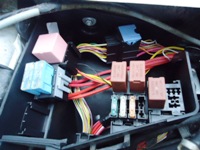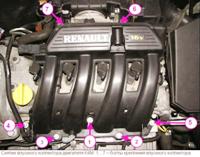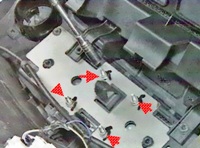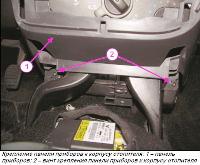Bleeding (bleeding) the hydraulic system of the power steering is necessary after any work related to the depressurization of the system (replacement of the pump or pipelines)
A sign of the presence of air in the system is the wedging of the steering wheel when you try to turn it sharply.
In addition, the pump makes an increased noise when the steering wheel is turned, and the liquid in the tank usually foams.
Brake the vehicle with the parking brake and place wheel chocks (“chocks”) under the rear wheels.
Raise the front of the vehicle and place it on jack stands so that the front wheels are off the ground. With a lift, you can raise the entire car.
Pour working fluid into the hydraulic booster system up to the “MAX” mark
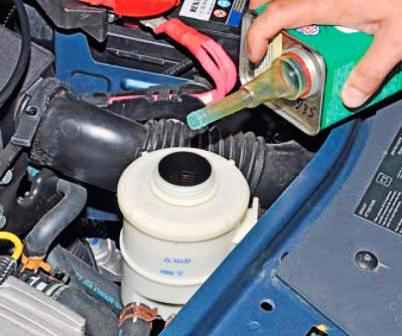
Without starting the engine, turn the steering wheel five or six times to the left and right until it stops.
Start the engine and turn the steering wheel all the way to one side. Do not increase the engine speed above idle speed.
Do not hold the steering wheel in the extreme position for more than 5 seconds.
Turn the steering wheel all the way in the opposite direction.
Return the steering wheel to the middle position and stop the engine
Check the hydraulic fluid level in the hydraulic booster reservoir and add fluid if necessary.
The level of the working fluid in the tank with a warm engine should be no higher than the "MAX" mark, and on a cold one - not lower than the "MIN" mark.
Repeat steps 4-7 until the fluid level in the reservoir stops dropping when you turn the steering wheel and air bubbles no longer appear in the fluid.
Add the required amount of working fluid. Do not pour liquid above the “MAX” mark.
Lower the front wheels on the ground.
Start the engine and make several full turns of the steering wheel from one end to the other.
Check that there is little difference in fluid levels in the reservoir when turning the steering wheel left and right.
Make sure that the difference between the fluid level when the engine is running and the level after the engine is stopped is within 5 mm.
If the level difference has reached 5 mm or more, it means that the air has not been completely removed from the system and pumping should be repeated.
Reinstall the reservoir cap and wipe off any spills.
The noise of the power steering when the front wheels are turned out to the limit is not a malfunction
Replacing the working fluid of the power steering system
You will need: pliers, a container for collecting liquid.
According to the manufacturer's recommendation, the fluid in the power steering system should not be changed during the entire life of the vehicle.
If the fluid in the tank is heavily contaminated or darkened, then it should be replaced.
If the liquid is very dirty or dark, check the serviceability of the power steering pump and steering gear. They may need to be repaired or replaced.
Do not reuse the drained fluid: it is contaminated, saturated with air and moisture.
Always fill the system with new fluid of the brand that was filled before.
Raise the front of the vehicle and securely support it so that the front wheels are off the ground.
If you have a lift, you can raise the entire car.
Drain (for example, with a syringe or a rubber bulb) the fluid from the power steering reservoir.
Squeeze the bent lugs of the liquid return hose clamp to the tank, slide the clamp along the hose and disconnect the hose
Dip the end of the disconnected drain hose into the prepared container.
If the length of the hose is not enough, extend it with a piece of any hose of a suitable diameter.
Drain the fluid from the power steering system by starting the engine two or three times for a few seconds while turning the steering wheel alternately in both directions until it stops.
Connect the fluid return hose to the power steering reservoir.
Fill fluid into reservoir and bleed air from power steering system. Do not pour liquid above the “MAX” mark.
Put the cork back in place and wipe off any drips.








